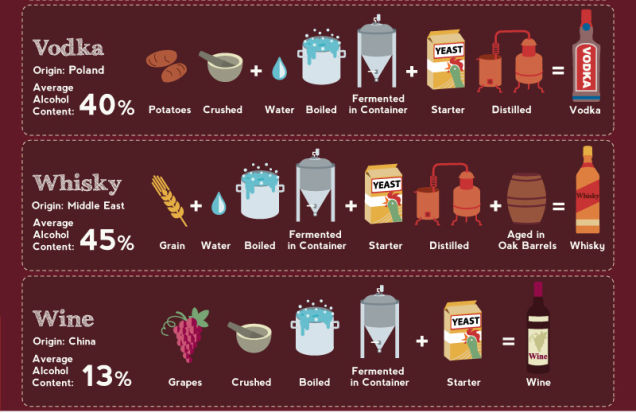Putting together an alcohol collection is challenging. What should you get? What will you really use?
In the early days of building up my home bar, I was filled with anticipation of entertaining friends and satisfying my curiosity of spirits and cocktails. The best advice that I have for someone looking to start their home bar is to focus on a spirit or cocktail that they really enjoy. Try buying the ingredients for that drink only. After you’ve mastered it, look to add one or two ingredients at a time to make a new cocktail. Inviting friends over for drinks can be a lot of fun and save you a lot of money in the long-run — drinks at home cost only $2-3 each. You can control the music, there’s no line for the bathroom, and you can actually hear what your friends are saying. Maybe I’m just getting old, but that sounds like a fantastic time.
Beefeater Gin, 750 ml, $14: This London dry gin is a classic recipe heavily featuring juniper. It’s versatile and isn’t like the cheap gin you might have had when you were younger. Another great, cheap alternative is Broker’s Gin.
This is the best rye for mixing cocktails on the market, presenting itself (only sometimes subtly) above the mixers of any drink. A slightly cheaper and acceptable alternative that many people use is Old Overholt or Bulleit Rye.
Bulleit Bourbon, 750 ml, $25: At 90 proof, this bourbon is a nice balance of sweet and bold. It’ll hold up in cocktails and is easy enough to sip. Fancy yourself a Maker’s Mark fan? The staple wheated bourbon is a fine substitute here.
Smith & Cross Traditional Jamaica Rum, 750 ml, $29: This navy-strength (>50% alcohol by volume) rum is perfect for cocktails. It’s not as sweet as many of the other rums that I’ve tasted over the years, which allows it to stand out. You might also consider Flor de Caña if you want a cheaper bottle to explore your preference.
To keep this list short, I had to leave out a lot of my favorite ingredients, but I intentionally left out vodka. Friends visiting my house for the first time are often confused as to how I could miss this spirit. I didn’t miss it — it’s absence is intentional.
Beginners with the interest in acquiring a palette for sophisticated spirits and cocktails might be surprised to find that quality gins provide a perfect balance to their previously preferred vodka drinks. Vodka is generally marketed as being free of impurities, “triple-distilled,” and with flavors like apple, cinnamon, and even cotton candy. If you’re not interested in tasting the alcohol in your drink, just find the nearest bottle of liquor and dilute it with any juice or soda of your preference.
That being said, there is a time and a place for everything. I love drinking vodka and eating caviar during celebrations with my Russian friends and drinking cheap, watery beers and other heavily diluted drinks on hot days. Of course, there are exceptions, as the loose definition of vodka allows for some interesting variations. I’ve tasted a few vodkas recently (with much coercion) that reminded me of some of my favorite gins. Cheap, high-proof vodkas can also be handy when creating tinctures, bitters, and infusions at home — but I haven’t gotten that far yet.
Unless you’re hosting a big party, I recommend grabbing the small bottles. After opening a bottle of tonic or soda, the carbonation and flavor change dramatically in a short period of time.
Carpano Antica or Dolin, 375 ml, $12-14 for better quality
Pick which one is best suited to your budget. Certain recipes are definitely improved with the more viscous Carpano Antica, but as you’re exploring your preferences, you won’t go wrong with the budget selections. I suggest picking up the 375 ml bottles because vermouth is a fortified wine, and as is the case with anything under 20% alcohol by volume (abv), it will lose its flavor over time. That being said, it will not likely reach the point of becoming undrinkable, and most people won’t know the difference. So you can also grab the 750 ml bottle if you’re doing some long-term planning. Just make sure to keep the bottle in the fridge for preservation.
Same as above. You can also use this as a substitute in your food recipes when they call for a dry white wine. Sometimes I realize that a recipe calls for a small amount of dry white wine and I either don’t have a bottle at home or don’t want to open a new bottle just for that meal.
Campari, 750 ml, $26 for people who love a bitter contrast in their drinks
Aperol, 750 ml, $27 for people who like a delicate balance of bitter and sweet
This bottle is entirely optional, as you can make a number of simple, classic cocktails without Campari or Aperol, but you are not likely to regret it. Per my Negroni post, Aperol really helps make it the perfect drink for any occasion. I like to keep these lower abv liqueurs in the fridge as well.
It’s crucial that you use only fresh-squeezed citrus juice in your cocktails. No ifs, ands, or buts about it. It’s really not hard to squeeze your citrus on an as-needed basis if you have a citrus squeezer handy. If not, just squeeze with your hand and catch the seeds with your free hand, or pick out the seeds before adding the juice to the rest of the ingredients. If you find that you’ve got leftover citrus, you can freeze the juice in an ice cube tray and use for recipes in the future.

record of the month

How to create a HOME BAR Essential alcohol to buy @TheDrCork
FAQ
What alcohol do you need to set up a bar?
